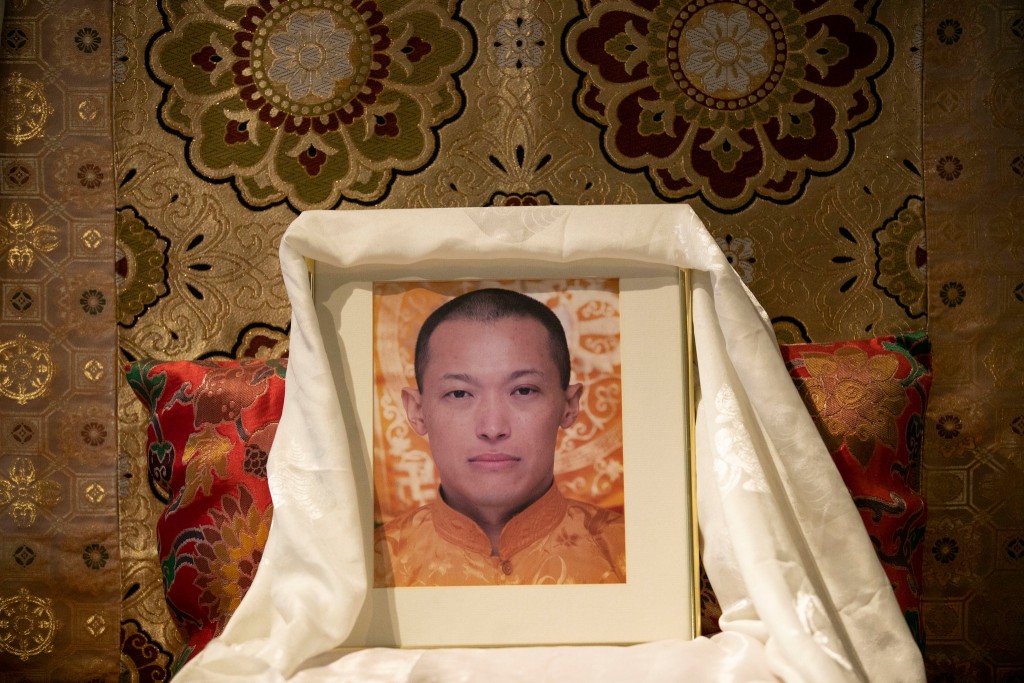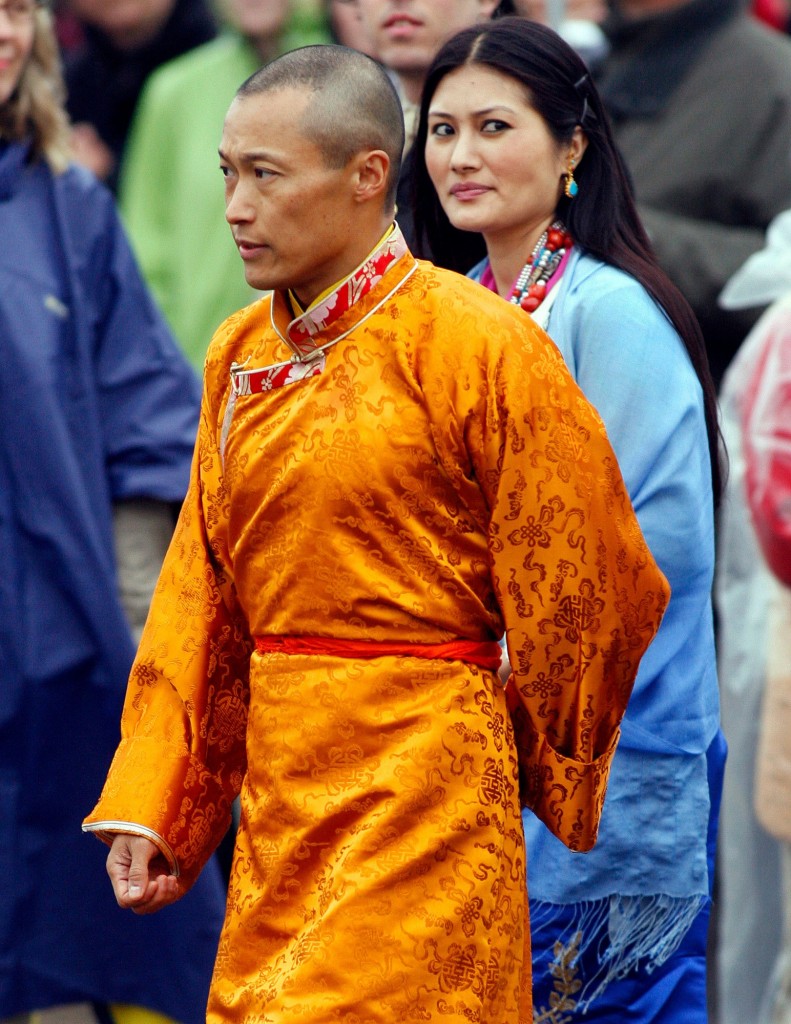By Andy Newman
July 11, 2018

A photo of Sakyong Mipham Rinpoche, the leader of Shambhala International, sits on a throne reserved for him inside the group’s New York center, but he has taken leave amid charges of sexual abuse.CreditGabriella Angotti-Jones/The New York Times
In a shrine on the sixth floor of a Manhattan office building, a photo of a man in golden robes hangs above an altar. Another photo of him sits upon a throne.
He is the head of one of the largest Buddhist organizations in the West, Shambhala International, a network of more than 200 outposts in over 30 countries where thousands come for training in meditation and mindfulness and some delve into deeper mysteries.
The man is Mipham Rinpoche. He is known as the Sakyong, a Tibetan word that translates roughly as king, and his students take vows to follow him that are binding across lifetimes. These days, they are feeling sad, confused, angry and betrayed.
Late last month, a former Shambhala teacher released a report alleging that the Sakyong had sexually abused and exploited some of his most devoted female followers for years. Women quoted in the report wrote of drunken groping and forcefully extracted sexual favors. The report said that senior leaders at Shambhala — an organization whose motto is “Making Enlightened Society Possible” — knew of the Sakyong’s misconduct and covered it up.
The Sakyong apologized a few days before the report was formally released, admitting to “relationships” with women in the community, some of whom “shared experiences of feeling harmed as a result.” Followers and Shambhala groups around the world demanded more action.
On Friday, it came: The governing council of Shambhala International, which is based in Halifax, Nova Scotia, resigned en masse, “in the interest of beginning a healing process for our community.”
That night, the Sakyong, 55, took leave from running Shambhala as an outside firm investigates abuse allegations against him and other Shambhala teachers. He would, the announcement stated, “enter a period of self-reflection.”
The Sakyong is not only another executive or religious leader dethroned by #MeToo, but the sole holder of the most sacred teachings in a custody chain that goes back centuries, the only one who can transmit them, according to the traditions of his lineage.
A few days before the Sakyong stepped aside, Ramoes Gaston, a volunteer at the Manhattan center, on West 22nd Street, who has studied Shambhala for eight years, said the revelations had ripped his world apart.
“I don’t want it to be exposed,” Mr. Gaston said. “But it has to be exposed.”
The downfall of a Buddhist leader in the West accused of sexual impropriety has become its own sorry tradition. Last year, Lama Norlha Rinpoche, who founded a monastery in Wappingers Falls, N.Y., retired after allegations of sexual misconduct. So did Sogyal Rinpoche, author of “The Tibetan Book of Living and Dying,” who was accused of decades of sexual assaults and violent rage. In the Zen tradition, fallen masters include Joshu Sasaki and Eido Shimano, two of the leading proponents of Zen in America.
In Shambhala, bad behavior runs in the bloodline. The organization was founded by the Sakyong’s Tibet-born father, Chögyam Trungpa, a wildly charismatic man, brilliant teacher and embodiment of the concept known as “crazy wisdom” whose alcoholic exploits and womanizing were well known. He died in 1987. In between Chögyam Trungpa and the Sakyong, Shambhala was led by an American-born Buddhist who is mainly remembered for having sex with students even after he knew that he had AIDS.
The hyperconcentration of authority in the most revered teachers of Tibetan Buddhism lends itself to abuse, said Lama Tsultrim Allione, one of the first American women to be ordained a Tibetan Buddhist nun and a former member of Chögyam Trungpa’s group who knew the Sakyong when he was a child.
“One is told that one must see the lama as the Buddha and that anything the lama does is perfect and that whatever might seem wrong with it, that is your impure vision. This can be a transformative practice, but only when the lama is truly awake,” said Lama Tsultrim, who leads a Buddhist center in Colorado and just published a book, “Wisdom Rising: Journey Into the Mandala of the Empowered Feminine.”

The Sakyong, with his fiancée, Khandro Tseyang, in 2006, has apologized to his followers, admitting to “relationships” with women in the community. He said he would enter “a period of self-reflection.”CreditAndrew Vaughan/CP, via Associated Press
In Shambhala, Lama Tsultrim said, “the level of institutionalized hierarchy is quite extraordinary,” with the Sakyong functioning “sort of like a divine king.” His inner circle, with its ministers and attendants, is called the “court.” He has a personal flag that local centers can buy for $350, to fly when he visits.
The woman behind the exposé, Andrea Winn, grew up in the Shambhala community in Halifax and says that she and many other children were sexually abused by adults in the community.
In early 2017 — months before #MeToo became a cultural phenomenon — she began a yearlong effort, “Project Sunshine,” to gather accounts by survivors of the abuse. The resulting report, published in February, prompted Shambhala International to announce “an effort to address issues of past harm in our community.”
The Sakyong praised survivors for “bravery and courage” in speaking out, without mentioning any misconduct of his own. But the report also prompted women who said they had been abused by the Sakyong to come forward, providing material for the second report, released June 28.
One woman wrote that for years, before he was married, the Sakyong would kiss and grope her when he got drunk. Like many women around the Sakyong, she desperately hoped to become his wife, she wrote, and she rationalized his boorishness by telling herself that the Sakyong was trying to show her “the patterns of my own poverty mentality and grasping.”
Another woman wrote that the Sakyong summoned her one night and when she refused to have sex with him, he pushed her face toward his penis and said, “You might as well finish this.” She wrote, “I was so embarrassed and horrified I did it.” A third woman wrote that the Sakyong groped her in 2011, after his daughter’s first birthday party.
Yet another woman came forward on Tuesday and said that at a dinner in Chile in 2002, a drunken Sakyong pulled her into the bathroom and locked and blocked the door.
“He started to grope me and try to undress me,” the woman said by phone, speaking on the condition of anonymity. “I was like ‘No, no, I have a boyfriend.’ He said, ‘It doesn’t matter.’” She said the Sakyong grabbed her hand and put it on his penis through his robe before she escaped.
With the exception of the 2011 episode, the allegations against the Sakyong date from before 2006. They were vetted by a retired employment lawyer, Carol Merchasin, who contacted Ms. Winn after the first report was released. Ms. Merchasin said she found all the accounts to be credible.
The Sakyong would not comment on the accounts “out of respect for the integrity of the independent investigation,” said his lawyer, Michael Scott.
Ms. Winn, 50, a leadership coach based in Halifax, said of the council’s resignation and the Sakyong’s stepping aside: “It came as a surprise, and as a huge relief. Now I feel that there’s this possibility for healing.”
Local centers are dealing with the fallout in their own ways. At a center in New Haven, the Sakyong’s photo has been taken down.
At a meeting at the New York center last week, several people who had found refuge in Shambhala from their own histories of addiction and sexual abuse said they no longer felt safe, and a teacher, Kevin Bogle, resigned in protest.
“I have been livid this entire week from the news that has been reported and the harm that has been committed,” he told the gathering.
Many of the Sakyong’s followers are praying for him. Mr. Gaston of the New York center said that when he sees the Sakyong’s photo above the altar, he thinks about the pain the Sakyong must have been in that would have led him to cause such harm to others. “With every breath I exhale,” he said, “I hope that some of my mercy is communicated to him.”
Source: https://www.nytimes.com/2018/07/11/nyregion/shambhala-sexual-misconduct.html
No comments yet... Be the first to leave a reply!